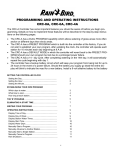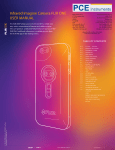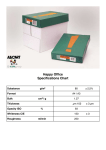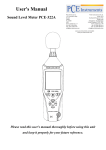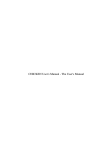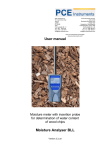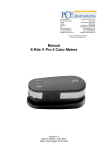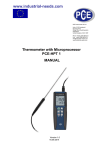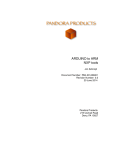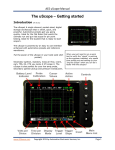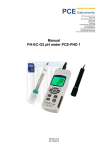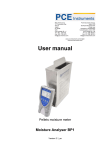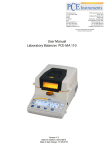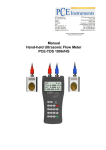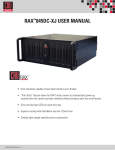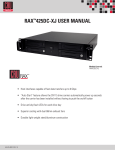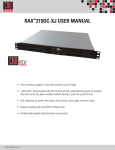Download 一 概述
Transcript
PCE Americas Inc. 711 Commerce Way Suite 8 Jupiter FL-33458 USA From outside US: +1 Tel: (561) 320-9162 Fax: (561) 320-9176 [email protected] PCE Instruments UK Ltd. Units 12/13 Southpoint Business Park Ensign way Hampshire / Southampton United Kingdom, SO31 4RF From outside UK: +44 Tel: (0) 2380 98703 0 Fax: (0) 2380 98703 9 [email protected] www.pce-instruments.com/english www.pce-instruments.com User Manual PCE-WSB 1 Spectrophotometer 1 1. General The WSB series digital Whiteness Meter is composed with lamp house, optical system, detection system, and data processing & display system, etc. The overall whiteness value is R457 of the whiteness degree of blue light. The whiteness degree on the ideal surface with the ratio of diffuse reflection in the spectrum as 1 is defined as 100, and the whiteness degree of absolute black surface with the ratio of diffuse reflection in the spectrum as 0 is defined as 0. This instrument is designed entirely according to the conditions for standard lamp house and lighting measurement regulated by International Commission for Lighting. It has passed the strict inspections and debugging, and executes the enterprise standard of Q/TDKY02-2004, with the national standards like GB2913, Gb5950, Gb8940.1, GB12097 and GB13025.2, etc applicable. 2. Working Theory Using the theory of the photoelectrical conversion, the instrument adopts the analog-digital conversion circuit, to magnify the signal of energetic value of radiating lightness reflected by the surface of the sample measured, to convert it from analog signal to digital signal, to process the data, finally to display the corresponding value of the whiteness degree. 2 3. Use The WSB series whiteness degree instrument with the digital display is mainly applicable for the measurement of the whiteness degree on the surface of the object or the powder in the white color and the color close to white. The whiteness degree can be accurately educed that is consistent with the visual degree. The opacity degree of the paper can also be accurately measured. This instrument can be widely applied for the measurement of the whiteness degree of the objects like textile & printing & dying, oil paint & dope, chemical construction material, paper & paper plate, plastic product, white cement, ceramics, porcelain enamel, porcelain clay, French chalk, starch, flour, salt, wash, and cosmetics, etc. 4. Features A、AC & DC power supply, low power consumption, cabinet and handsome contour design, facilitating field and lab use; B、Configured with auto power-off function and low power dissipation circuit, able to effectively prolong service life of battery; C、Adopting big-screen highly transparent LCD display, with comfortable reading, and free of ill influence from sunlight; D、Adopting low-drift and high-accuracy integrated circuit, efficient and timeproof light source, effectively ensuring long reliable performance。 E、Unique locative structure and high-accuracy light path system, effectively ensuring exactness and repeatability; F、The simple operation, and can accurately measure the opacity degree of the paper G、Adopt the standard white plate rated by the central government to convey the 3 standard value, and the measurement is accurate and reliable H、 Configured with output port of measured values, possible to connect with recording meter 5. Precautions This instrument is a kind of the measurement tool, not allowed to be disassembled, please carefully read the operation manual before use. A、The working environment should have no erosive gas or vibration source. B、There should be no radiation of strong lamp house and interference from strong magnetic field in the surrounding area. C、The air in the surrounding area should be dry, and should not have the floaters like powders and dusts, etc. D、After stopping for long time, the instrument should extend the preheating period accordingly, so as to improve the stability. E、The power voltage must comply with the working conditions. F、It is strictly not allowed to drop the sample into the measuring cylinder, to avoid being unable to make the clearance to zero. G、It is not allowed to directly touch the optical component with the hand, avoiding affecting the characteristics of the spectrum. H、The black cylinder and the working white board are not allowed to be polluted, avoiding to affect the accuracy. 4 6. Technical Indicators Model WSB-1 Parameter Measurement scope 0~100.0 Whiteness degree of blue light Formula for whiteness degree Wb﹦R457 The lamp house closes to A or the Lamp house simulated D65 lamp house, complying with the regulations in the CIE standard Lighting measurement 45/0 conditions Monitor LCD monitor Accuracy of display value 0.1 Zero excursion 10mim 0.1 Excursion of display value 0.2 10mim Repetition of measurement 0.3 Error of the display value 1.5 Application environment Temperature: 5℃~35℃, Humidity: ≤85%RH DC 1.5V, 5 AA alkaline dry cells Working power AC 220V/50Hz DC7.5V 0.2A power supply adapter Signal output 0~2V mating with recording meter with input impedance >100KΩ 7. Notes for use (一)Notes for use 1. Before using the instrument, you must carefully read this operation manual, 5 and strictly follow the regulated working conditions and the operation method. 2. The standard working white plate is for the calibration and the standard confirmation when the instrument works, and the surface must be kept clean, especially the standard working white plate is not allowed to expose in the dusts, to avoid from artificially affecting its nominal value. 3. Before starting up the machine to work, you should use the clean cotton cloth that will not drop the feather or the paper to clean the sampling base and the measurement hole on the instrument, to avoid from polluting the white plate and the measurement sample. 4. The surface of the sample to be tested should be even and level.When repeating the test, you should keep the consistency of the tested sample in the horizontal and vertical directions. For the measurement of the sample that is not level and even to be tested (such as powder, grain, or fiber shape, etc), please refer to the sample fabrication for the sampling method. (二)Sample fabrication 1. If the measurement surface on the sample has the “uneven” phenomenon that cannot be improved, or has difference of the grain mark in the horizontal and vertical directions, the sample can be measured in different positions or angles, and to calculate the average value of the whiteness degree, to represent the whiteness degree of this sample. 2. For paper, cloth, and various kinds of fiber fabrics, the sample with the several layers overlapped should be used until it will not be transparent (if it’s paper, according to the regulations in QB534-67, use several pieces of the samples overlapped for 50×70mm, until it will not be transparent, i.e. when adding the number of the samples until the whiteness degree will not be 6 changed, it will not be transparent). Place the sample on the sample base, and it is better that the vertical direction is parallel with the measuring personnel (parallel with the direction of the instrument panel). 3. For the samples of powder or tiny sample in the grain shape, the sample should be placed in the powder utensil, and the glass plate with the clean and bright surface should be used to press the surface of the sample to be level. Due to the different testing conditions will bring the different testing results, to establish the relationship of the whiteness degrees between the similar samples, the sampling method for the samples to be tested must be uniformly regulated, including weight, granularity and compaction method, to make the samples have the similar densities and the level degrees on the surfaces. If requiring the relatively high measurement accuracy, the constant-pressure powder-molding machine produced by our factory should be purchased. 4. For the articles in the fiber shape, such as cotton, fiber, wool and silk, etc, it should be first cleaned up, to comb into a surface in the vertical direction, and then it should be placed in the self-made sampling box to test. The sampling method (including the quantity) should be uniform. It is better to make more samples and test their average value. (三)Preparation for the test 1. Start up and preheat: Switch on the power cable, and start the power switch on the instrument. At this moment, the display screen should have displayed the numbers, and preheat the machine for 30 seconds. 2.Prepare the standard white plate and the black cylinder for the calibration. 3.Prepare the samples for the measurement 4. Zero clearance 7 Press the pressing board of the sliding cylinder on the sample base to place the black cylinder on the sample base, then raise the sliding cylinder to the measurement hole. After a moment for the display value is stablized, press the zero-clearance button, the display value will be automatically cleared to zero. 5. Calibration Take off the black cylinder, put the standard working white board on it. After the display value is stabilized, press the calibration button to calibrate, make the display value be consistent with the value of whiteness degree on the standard plate. 6. Convey the value of whiteness degree of the standard working plate Take off the black cylinder, put the standard working white board on it. After the display value is stabilized, adjust the calibration knob on the panel, make the display value be consistent with the value of whiteness degree on the standard plate, take off the standard working white plate, place the standard white plate for reference & comparison on it. After the display value is stabilized, record the value of whiteness degree, use it as the nominal value when measuring the sample to confirm the standard, then place the standard working white plate into the dry utensil filled with the silica gel for storage. 7. Measurement method For the continuous measurement of the sample with the high requirement for the contrast level, it should be calibrated with the standard white plate, to avoid the impact of the excursion of the display value on the instrument. When the sample is placed on the sample base, its level degree should be 8 noted. (1)Measurement of the R457 whiteness degree: After pre-adjusting the instrument, the sample to be measured can be placed on the sample base. After the display value is stabilized, the value of whiteness degree can be recorded. (2). Measurement of the opacity degree T: Test complying with the method of regulations in ISO2471-77.After pre-adjusting the instrument, the sample should be measured, and have sufficient thickness. The number of layers is limited as being opaque. a. Place the sample on the instrument to be measured, then take off the uppermost layer of the sample and put it in the lowest layer to be measured, with five layers of samples to be measured in total, and record the light reflection factor R∞ in each layer of the sample. b. Make the black cylinder as the underlay for the five layers of the samples that have been measured as described above, and record the light reflection factor R0 on the surface of each layer. c. Repeat Procedure a and b, measure the values of R∞ and R0 on each layer of the original sample respectively. d. Calculate the average value of R∞ and R0 on both the front side and the opposite side of the sample. e. Calculate the opacity degrees (T) on the front side and the opposite side: R0 T=100—— R∞ Calculate the opacity degree on each side, with the accuracy to 0.5%. If the difference is greater than 0.5%, the opacity degrees on the front and 9 opposite sides should be appraised respectively. If the difference is not greater than 0.5%, all the average values will be reported. 8.The instrument will automatically close down in 15 minutes ever since start-up. 8. Maintenance and Service of the Instrument (一)Maintenance 1. Standard for the white board The random standard working white board should be submitted to the superior measurement authority or the industrial testing central station for the review and the approval on a periodic basis, for once a year. If being polluted, it should be cleaned and sent for the inspection and reconfirm the standard in a timely manner. 2. When measuring powder or tiny granule-shape sample, the sliding cylinder should be carefully and slowly raised and lowered, so as to avoid the sample from dropping into the measurement hole, and the instrument from being able to be cleared to zero and the inaccurate measurement. (二) Warranty Within one year since the purchasing date of the instrument by the customer, while the customer follows the operation instructions regulated for the instrument to operate and use. If the instrument is damaged or unable to work due to the problem of the manufacturing quality, the manufacturer will be responsible to repair the instrument for the customer for free. For the instrument damaged due to the improper operation by the customer, the manufacturer will charge the fees for the accessory and the labor accordingly. For the products with the warranty expired, the manufacturer will be 10 responsible for the maintenance for life. 9. List of Package No. Name Unit Quantity 1. The mainframe Set 1 2. The accessories Standard white working plate Piece 1 Standard white plate for reference and Piece 1 Black cylinder Piece 1 Powder utensil Piece 2 Manual Piece 1 comparison 11











